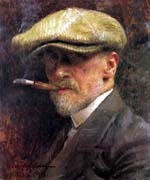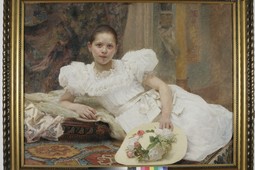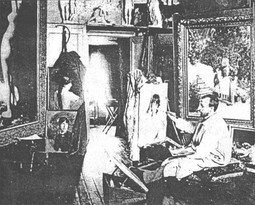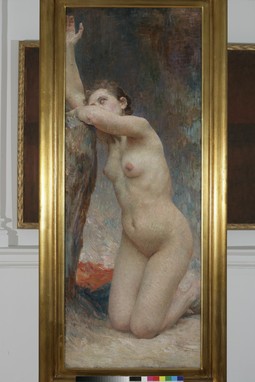'SELF PORTRAIT WITH A SPORTS HAT' One of Bukovac's best known oil on canvas self portraits, created in Prague in 1914, is owned by Zagreb's Modern GalleryVlaho Bukovac - A Cosmopolitan Croatian, a magnificent exhibition to be staged at The Hague's Gemeentemuseum, will be the biggest showing abroad to date of Bukovac's work, from Prague to London, and will feature over a hundred top works, oils for the most part, and some sketches and studies, from all of Bukovac's phases, from Paris and Zagreb to Cavtat. Besides paintings from Zagreb's Modern Gallery and a dozen museums from the wider region, such as Belgrade's National Museum, the Bosnia & Herzegovina Art Gallery in Sarajevo and Dubrovnik's Art Gallery, this exhibition will for the first time also include some of the paintings held by private Croatian collectors, well known for their priceless collections, such as politicians and businesspeople Ivo Sanader, Nadan Vidosevic, Ivica Todoric, Dr. Bozidar Grgic and football player Davor Vugrinec.
The prices of Bukovac's paintings on the European market are expected to rise after the exhibition in The Hague, like they did after the presentation in Prague, when the prices of Bukovac paintings jumped 300 percent. Some of Bukovac's exceptional works have fetched as much as 100,000 pounds at auctions held by Christie's or Sotheby's, as was the case with the oil on canvas The Artist's Family in Cavtat, recently purchased for Ivica Todoric. That is, however, in the opinion of experts, a precedent because there are not many top Bukovac oils on the market, and the prices of his paintings, which are not considered masterpieces, are on the average from 50 to 60 thousand euro. If, however, an unknown masterpiece were to appear on the market, which is possible because Bukovac was a hyper-productive painter who left a massive number of works in the Czech Republic and sold his works to numerous English merchants, connoisseurs say that an oil painting like that could fetch a prices as high as one hundred thousand pounds. The exhibition of the works of Vlaho Bukovac, one of the major representatives of modern art in Croatia, a polyglot, self taught musician, passionate cyclist, animal and stellar observation enthusiast, environmentally aware, an excellent organiser of art life and a savvy businessman, opens at the Netherlands' premier museum, the Gemeentemuseum in The Hague, on 26 September, and will run for over three months, through to 10 January of next year.
The paintings will be exhibited on the ground floor, in the 12 rooms of the Gemeentemuseum, known for its pre-Paris collections of works by Piet Mondrian and Vincent van Gogh and a collection from the Hague School shown a few years ago in Zagreb. Besides his paintings, a corner of the exhibition will be dedicated to the personal effects of the great artist, from his inseparable cigarette holder to his charming autobiography. "We will also present a new line of Croata Cravat scarves and neckties featuring motifs from Bukovac's oil paintings, available for purchase at the Gemeentemuseum in The Hague," says Biserka Rauter-Plancic, the director of Zagreb's Modern Gallery, where preparations are at full pace these days for the Bukovac exhibition. "Our art restorers will travel to The Hague together with the paintings to assist in fitting together the massive frames, important to the overall impression of Bukovac's canvases. Bukovac, namely, designed the frames of some of paintings, for the gold plated wooden frame on the magnificent oil Gundulic's Dream, for example, or as the author of the exhibition, Igor Zidic, refers to it more precisely - Gundulic Dreams Osman - after which woodworkers then shaped the frames from his drawings. That is why the frame and the painting are a whole and should not be separated."
Former Prime Minister Ivo Sanader will appear on the international scene as a collector for the first time at this exhibition with his small 1920 oil on canvas, Repairing Nets, confirmed by the Sanader Collection tag. And while art circles have for years been rife with rumour concerning his priceless collection, which allegedly includes first class oils by the highest priced Croatian artists, Sanader has not to date revealed either the content or the value of his collection, which has opened the way to speculation. The oil painting was selected for the exhibition, explained exhibition author Igor Zidic, because it shows Bukovac's tendency toward Impressionism.
"Although Bukovac was not given to risk, and the fact that painting was for him a profession he needed to earn his living from, this oil painting is technically interesting and shows that Bukovac knew and valued the Impressionists," says Zidic. There has also been rumour and speculation for years concerning the value of the costly collection owned by businessman Ivica Todoric, and the news has leaked to the public now that his new large oil, The Artist's Family in Cavtat, will be travelling to The Hague, recently purchased at a London auction for a dizzying 100,000 pounds. "I included it in the exhibition because it was not to be expected that Bukovac would have worked from a photograph at the time," says Zidic. "But he intervened in the original and left out the maid, leaving the portrait of only the family." Young Man And Girl At The Fountain will also be shown to the public for the first time, owned by football player and passionate but reticent collector Davor Vugrinec of Varazdin, who has spent years collecting the valuable and costly paintings of Croatian artists.
PORTRAIT OF MISS BERGER, an oil painting from 1897, 85 x 110 cm, painted in ZagrebHis imposing collection, which he revealed this spring exclusively for Nacional, includes meticulously selected top works by Kraljevic, Medovic, Uzelac, Crncic, Vidovic, Babic, Stancic, Job, Rezek, Srnec, Dzamonja and others, and connoisseurs say that some could fetch as much as 50 to 300 thousand euro on the market. Also on exhibition will be the stunning 1882 nude La Grande Iza from Novi Sad, and the newly discovered Portrait Of Ivan Vrankovic, a Split notable, kept by his grandson Vedran Deletis Vrankovic of Starigrad on the island of Hvar. The greatest collector of Bukovac paintings, Dr. Bozidar Grgic of Zagreb will lend the exhibition five of his works, prominent among them being the Portrait Of Gustav Pongratz, a man wearing a blue necktie, which has served the organisers as a leitmotif for the launch of the line of neckties featuring motifs from Bukovac's oils. Nadan Vidosevic will lend out the oil painting Christ On The Bier, kept at the Modern Gallery. Another interesting oil painting is Pink Dream from the Kraljevski dvor Foundation in Beli dvor, which once adorned the Tito residence. "I did not select the works by a theme, but rather following the principle 'the best of the best of Bukovac's works,' so that the exhibition will include portraits, the most important of his works, and landscapes, beautiful and Impressionist, to the figural compositions he had great talent for and in which his skill came most to the fore," explains exhibition author Igor Zidic.
"These are, for example, Gundulic's Dream and Five Senses, even though in my opinion and by modern sensibilities some of his portraits are his finest works. The exhibition will aim to situate Bukovac's works in the frame of the European art of the period. We wish to show, namely, that Bukovac participated in evolutionary art movements such as Impressionism and Symbolism, which is seen in his paintings Memento of a Family, Wardrobe of Future Glory and Fantasy, which he painted at the start of the 20th century. These works, along with those of Bela Cikos Sesija, are numbered among the first works of Croatian Symbolism. We would also like to rehabilitate the academic portion of his works and demonstrate thereby that academism was a legitimate variant of 20th century art." Zidic revealed that he did not include some of Bukovac's works in the exhibition, regardless of their professional quality, but rather chose those in which the great artist was not "doing courtesy" to someone. Bukovac, namely, has an imposing number of works and painted many official portraits on commission, like that of Emperor Franz Joseph, in which he was not given freedom to interpret. "I did not wish to depict him as an official portrait painter, who worked for money, but above all as an excellent artist," says Zidic. "When painting a portrait of the emperor or some politician, namely, he had to pay attention to the suit, the pose and countless official details, but when he painted a portrait of his young relative in Cavtat he could show his talent in full." "With this exhibition we are entering the global art scene in a big way," says Biserka Rauter-Plancic.
THE STUDIO ON ZRINJEVAC SQUARE Vlaho Bukovac in his Zagreb studio, which he built in the garden, right next to a magnificent four-storey residential building on Zrinjevac Square"Bukovac's works will not be presented in some culture centre on the outskirts of town, but rather at the leading national museum in the Netherlands, and this is the first step in giving him the place he deserves. This is not a significant exhibition only because we will show the world what we have, but also because Vlaho Bukovac is, as a brilliant portrait painter an excellent choice for the right presentation of Croatia in the world." The exhibition is valued at 2.1 million euro, and the costs of staging it will be divided among Croatia and the Netherlands, which indicates that the Dutch have recognised Bukovac's qualities and that they are ready to invest into the project. Indicative of this is the fact that the Dutch curators have given the exhibition its name, suggesting a play on words - a cosmopolitan Croat, or, a Croatian cosmopolitan. The Dutch will finance the production, printing and promotion of a luxurious catalogue, the printing of posters and invitations and the packaging and transport of the paintings from Zagreb to The Hague and back. As we were told by the director of the Modern Gallery, they will also cover the "enormously costly insurance for art at the Gemeentemuseum."
"It is clear to everyone that this is a priceless treasure. The paintings are estimated to be worth from 100,000 to 500,000 euro, and some works, such as Gundulic's Dream, are estimated at a dizzying 700,000 euro," says Biserka Rauter-Plancic. "That sounds like a lot at first, but these are large oil paintings of four metres. On the Croatian side the exhibition has been assisted by the Ministry of Culture, general sponsor Privredna Bank of Zagreb (PBZ), without which Bukovac would not be travelling to The Hague, the Tourist Board of the City of Zagreb, and the Agrokor Corporation, while the insurer Croatia Osiguranje is covering the insurance in the region. We had to clean and prepare many of the works for exhibition," explains Biserka Rauter-Plancic.
"The paintings will be transported from Zagreb to The Hague in a massive tractor-trailer organised by the Austrian firm Kunst Trans, one of the three best European companies specialised in transporting art. The tractor-trailer will have a strong security complement and escort and three drivers who will take turns at the wheel. The strict provisions of the contract, namely, stipulate that there must be no stoppages until the truck reaches the Gemeentemuseum in The Hague. The paintings will be transported in specially built wooden cases that contain a special protective packaging that includes rubber, air foil, silk paper and moisture collecting granules. The case will also have a special micro air conditioner that will maintain the strictly determined temperature and moisture levels to prevent damage to the paintings." In his essay for the exhibition catalogue Igor Zidic describes the stirring and adventurous life of Vlaho Bukovac. "He was born in Cavtat to a family of modest means and often struggled to survive in his youth, frequently changing the his place of residence, and lived in Prague, Vienna, Paris, Zagreb, New York, San Francisco and Lima," says Zidic.
MAGDALENA, an 1898 nude done in oil in Zagreb, kept at the Modern Gallery"He came to Paris as a 22-year-old youth, without a regular secondary school education and no art training, penniless and unable to speak French, and went on to study at the best French art academy with the famed Cabanel. When he left Paris 16 years later, he had 16 appearances at the renowned Paris Salon under his belt, a house on Montmartre and a villa in Fontainebleau which he left to 'his Mignon'." Bukovac's Zagreb years were dramatic. When he came back to Croatia in 1893 he succeeded in the space of only five years, says Zidic, in completely changing the attitude towards art and in becoming the central figure of the art scene in Zagreb. "His Zagreb years were characterised by an argument with Izidor Krsnjavi, then the top culture figure in Croatia, who immediately lost his flock upon Bukovac's arrival in Zagreb," explains Zidic, adding that he was also not liked by Ljubo Babic, who considered him a bourgeoisie painter, and that he was later not liked by the Communists either. "Bukovac cause an immediate revolution on the Zagreb art scene - he began attracting young artists and writers, encouraged the construction of the first studios and organised the first modernist exhibitions. Wealthy clients and the nobility competed to commission a Bukovac portrait. For the Millennium Exhibition in Budapest he convinced Croatian artists to seek an independent, prefabricated Croatian pavilion, the steel construction of which was later moved to Zagreb to become the Art Pavilion."
Zidic says that there is speculation that the real reason he left Zagreb was the construction of an impressive four-storey residence with a large studio in its garden on Zrinjevac Square that he erected with his own money and funds provided by his wife. He was criticised then by some members of the government and simply was unable to survive in those conditions. He withdrew to his native Cavtat where he renovated his grandfather's house and built an annex studio, and not long afterwards moved to Vienna and then Prague where he passed away. His ashes were transported to the cemetery in Cavtat. "Despite having received numerous medals at French exhibitions and having done portraits in the English court for years, he could not even get the post of a professor at the Zagreb Art Academy. His Croatian colleagues even tore the page bearing his name from a French monograph of contemporary painters by portrait painter M. A. Belin because their envy would not allow them to accept this fact," concludes Zidic.
A small, but valuable, oil painting
■ It is well known that former Prime Minister Ivo Sanader has an imposing collection of valuable and costly paintings by Croatian artists. For this exhibition of the works of Vlaho Bukovac in The Hague he will lend Repairing Nets, a small oil painting from 1920 that shows, says Igor Zidic, Impressionist influences.








